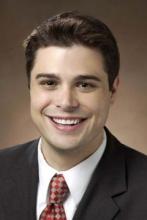TORONTO – Mitral valve repair rates continue to show great variability, ranging from zero to 90% for patients with moderate to severe mitral regurgitation, according to data presented by Dr. Damien J. LaPar, a thoracic surgeon at the University of Virginia, Charlottesville.
Surgeons performing more than 20 mitral cases per year were about three times more likely to perform a repair over a replacement compared with surgeons performing fewer than 20 mitral surgeries per year.
"Average annual surgeon volume appears more significantly associated with an increased likelihood for mitral repair than institutional volume," Dr. LaPar reported at the annual meeting of the American Association for Thoracic Surgery.
Mitral valve repair appears to be underused despite accumulated data favoring repair over replacement in the treatment of patients with moderate to severe mitral regurgitation. Dr. LaPar and colleagues evaluated the relationship between procedure volume and propensity for mitral repair (over replacement) in a multi-institution, regional cohort of patients.
The Virginia Cardiac Surgery Quality Initiative is a voluntary consortium of 17 collaborating cardiac surgery centers in Virginia that captures about 99% of all the operations performed in the state, with each center contributing their data to the Society of Thoracic Surgeons (STS) Adult Cardiac Surgery Database.
Records for 4,178 patients were evaluated from 2001-2012; 2,516 of these patients underwent isolated mitral valve replacement and 1,662 underwent isolated mitral valve repair. To deal with issues of confounding, a propensity matched cohort was developed including 1,661 patients in each group.
Median annual mitral procedure volume was 54 cases per year for hospitals, ranging from 5 to 128, and 13 cases per year for individual surgeons, ranging from zero to 58 cases. Mitral valve repair rates also ranged significantly, from 35% to 70% of all mitral valve procedures for hospitals and from zero to 90% for surgeons.
As expected, mitral valve replacement patients presented with higher STS PROM (5.6% vs. 1.7%, P less than .001), higher age, and a greater number of comorbidities.
When the researchers adjusted for STS PROM, both average annual hospital (P = .04) and surgeon (P less than .0001) mitral procedure volume were associated with probability of mitral repair, with surgeon volume showing more influence in the decision to repair rather than replace the mitral valve.
When the propensity to perform mitral valve repair was plotted against surgeon volume, the researchers saw a clear "inflection point" of increased probability for repair over replacement when the average annual surgeon mitral volume (used as a surrogate for surgeon experience) exceeded 20 operations per year. This finding was validated in the propensity matched cohort.
"We did a post hoc analysis and demonstrated that when you categorize volume by our visible threshold of 20 cases per year, for both hospital and surgeon volume in the overall cohort, hospitals and surgeons performing more than 20 cases per year, more strongly performed mitral valve repair," reported Dr. LaPar.
Indeed, among surgeons and hospitals performing more than 20 mitral operations annually, repairs were done in 62% of cases, compared to 37% for lower-volume centers. Among surgeons performing more than 20 mitral cases per year, repair rates were 73% compared to 26% for lower-volume mitral operators (both P less than .001).
Similarly significant differences were seen in the propensity matched cohort, although the effect was more muted (53% vs. 47% for high- and low-volume hospitals and 67% vs. 39% for high- and low-volume surgeons; P less than .001 for both).
"In the upcoming era of percutaneous mitral valve repair technology, we believe that surgeon volume and expertise should act as a gatekeeper and should dictate not only access to this technology but the role of surgeons and cardiologists in this," concluded Dr. LaPar.
"This will be an excellent contribution to the literature further defining the relationship between surgeon volume and hospital center volume in mitral valve surgical outcomes and choice of operation," said the invited discussant, Dr. David A Fullerton, professor of surgery and cardiothoracic surgery at the University of Colorado at Denver, Aurora.
Dr. Daniel Drake, the current head of the Michigan Society of Thoracic and Cardiovascular Surgeons Mitral Initiative, added that in his state they have started to see a greater number of referrals – based on an assessment of case complexity – from less experienced surgeons to more experienced surgeons.
Dr. LaPar agreed that this would be a good solution, but noted that he hadn’t yet seen this happening widely in Virginia.
Dr. LaPar and Dr. Fullerton reported having no financial disclosures.


